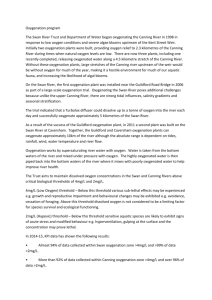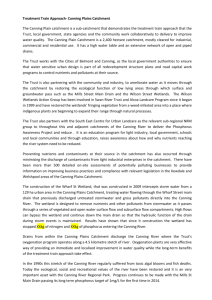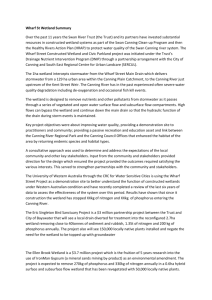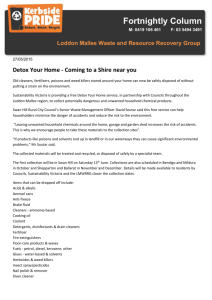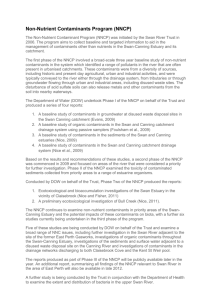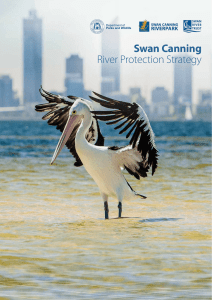Summary of monitoring and improved river health The Swan
advertisement
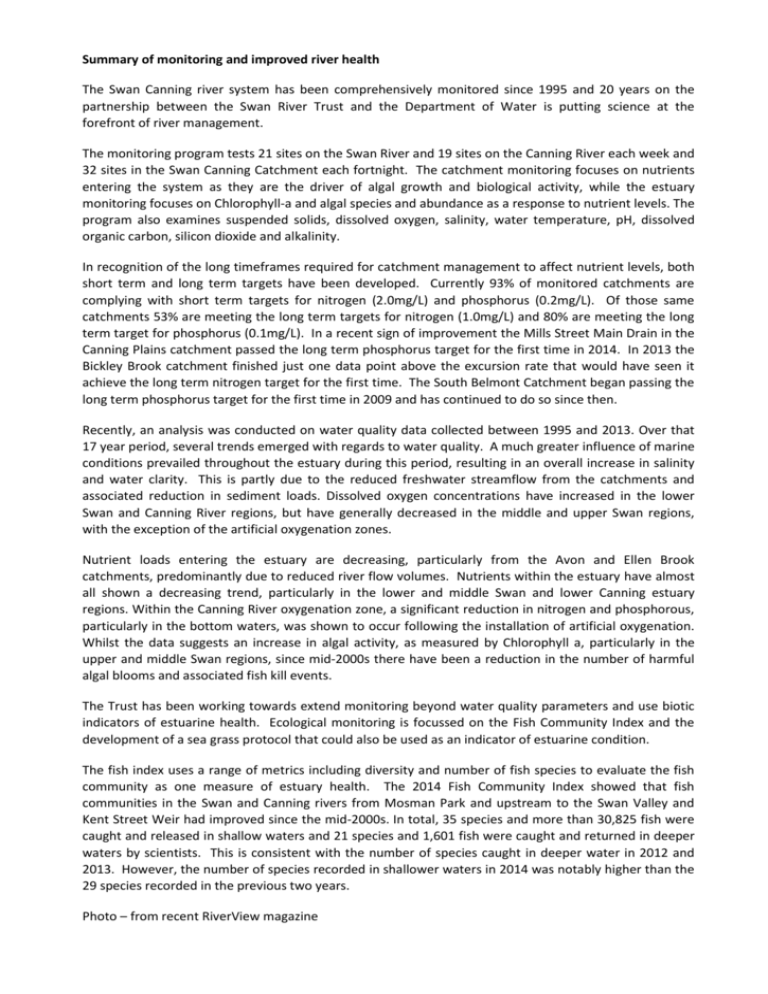
Summary of monitoring and improved river health The Swan Canning river system has been comprehensively monitored since 1995 and 20 years on the partnership between the Swan River Trust and the Department of Water is putting science at the forefront of river management. The monitoring program tests 21 sites on the Swan River and 19 sites on the Canning River each week and 32 sites in the Swan Canning Catchment each fortnight. The catchment monitoring focuses on nutrients entering the system as they are the driver of algal growth and biological activity, while the estuary monitoring focuses on Chlorophyll-a and algal species and abundance as a response to nutrient levels. The program also examines suspended solids, dissolved oxygen, salinity, water temperature, pH, dissolved organic carbon, silicon dioxide and alkalinity. In recognition of the long timeframes required for catchment management to affect nutrient levels, both short term and long term targets have been developed. Currently 93% of monitored catchments are complying with short term targets for nitrogen (2.0mg/L) and phosphorus (0.2mg/L). Of those same catchments 53% are meeting the long term targets for nitrogen (1.0mg/L) and 80% are meeting the long term target for phosphorus (0.1mg/L). In a recent sign of improvement the Mills Street Main Drain in the Canning Plains catchment passed the long term phosphorus target for the first time in 2014. In 2013 the Bickley Brook catchment finished just one data point above the excursion rate that would have seen it achieve the long term nitrogen target for the first time. The South Belmont Catchment began passing the long term phosphorus target for the first time in 2009 and has continued to do so since then. Recently, an analysis was conducted on water quality data collected between 1995 and 2013. Over that 17 year period, several trends emerged with regards to water quality. A much greater influence of marine conditions prevailed throughout the estuary during this period, resulting in an overall increase in salinity and water clarity. This is partly due to the reduced freshwater streamflow from the catchments and associated reduction in sediment loads. Dissolved oxygen concentrations have increased in the lower Swan and Canning River regions, but have generally decreased in the middle and upper Swan regions, with the exception of the artificial oxygenation zones. Nutrient loads entering the estuary are decreasing, particularly from the Avon and Ellen Brook catchments, predominantly due to reduced river flow volumes. Nutrients within the estuary have almost all shown a decreasing trend, particularly in the lower and middle Swan and lower Canning estuary regions. Within the Canning River oxygenation zone, a significant reduction in nitrogen and phosphorous, particularly in the bottom waters, was shown to occur following the installation of artificial oxygenation. Whilst the data suggests an increase in algal activity, as measured by Chlorophyll a, particularly in the upper and middle Swan regions, since mid-2000s there have been a reduction in the number of harmful algal blooms and associated fish kill events. The Trust has been working towards extend monitoring beyond water quality parameters and use biotic indicators of estuarine health. Ecological monitoring is focussed on the Fish Community Index and the development of a sea grass protocol that could also be used as an indicator of estuarine condition. The fish index uses a range of metrics including diversity and number of fish species to evaluate the fish community as one measure of estuary health. The 2014 Fish Community Index showed that fish communities in the Swan and Canning rivers from Mosman Park and upstream to the Swan Valley and Kent Street Weir had improved since the mid-2000s. In total, 35 species and more than 30,825 fish were caught and released in shallow waters and 21 species and 1,601 fish were caught and returned in deeper waters by scientists. This is consistent with the number of species caught in deeper water in 2012 and 2013. However, the number of species recorded in shallower waters in 2014 was notably higher than the 29 species recorded in the previous two years. Photo – from recent RiverView magazine
